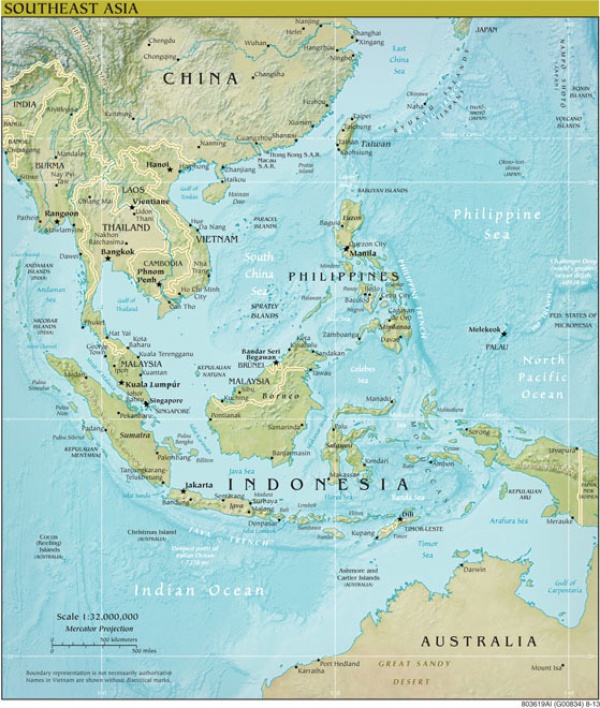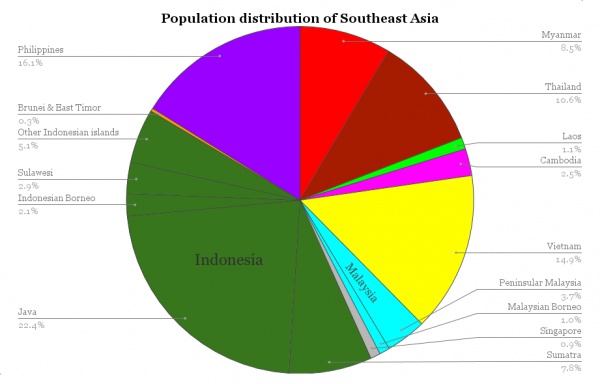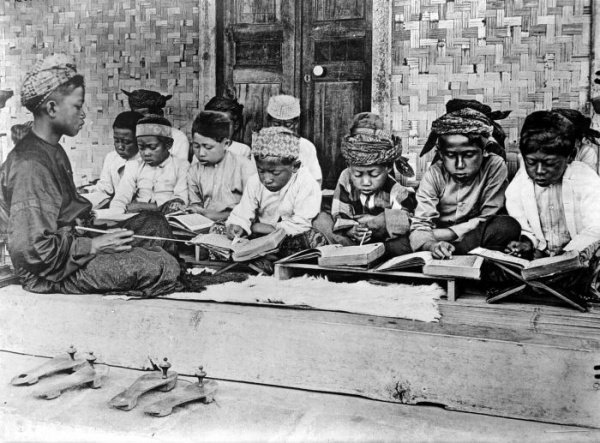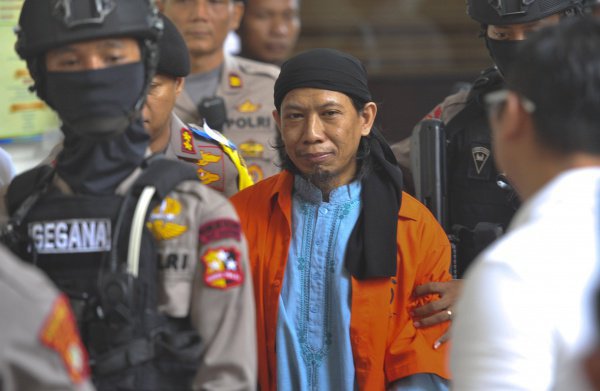The rise of radical Islam in the Southeast Asia over the last years is attracting the global attention. Southeast Asia has a significant Muslim population, make up 40 percent of the world's Muslims. Regional demography gives it immense potential importance in the concept of expanding a global caliphate. It makes the region a prime target for religious extremists who believe in the imposition of Sharia religious law by violent means.
Southeast Asia is a broad region characterized by coexistence of various religious. We can distinguish predominantly non-Muslim nations, such as Vietnam, Laos, Cambodia, Thailand, or East Timor. Contrary, several Southeast Asian nations (Indonesia, Malaysia, and Brunei) are predominantly Muslim, with a small minority of other religions.

Political Map of the Southeast Asian region / Public Domain
The nature of Islam in Southeast Asia is considered more moderate than in the Middle East due to the multiple religions and multicultural influences. Southeast Asia is often portrayed as a representative model of progressive Islam, regardless of the daily reality with growing intolerance toward religious minorities and numerous terrorist attacks across the region over the past two decades. The religious composition of Southeast Asia Muslim-dominated countries has influence with the countries legal norms and mechanisms deploying rising formal and non-formal discrimination against religious minorities.
The threat of radical Islam does exist and could be a future significant problem for regional and worldwide security.
Growth of radical Islam in Southeast Asia: a brief overview
The growth of radical Islam in Southeast Asia has been catalyzed by the Islamic revival and funds from the Middle East, mostly Saudi Arabia. Radical Salafist groups have spent considerable funds on Islamic boarding schools (pesantren), charity (sedekah), building mosques and funding preachers in Southeast Asia. Saudi funds under the cover of religious and educational purposes are dedicated for spreading extremism views, playing a central role in radicalizing young people. Such education causes warning social issue – the majority of Islamic preachers serving among local communities tends to present to conservative interpretations of Islam due to the fact that they graduated from Islamic boarding schools which promote more hardline understanding of Islam.

Population distribution of the countries of Southeast Asia (with Indonesia split into its major islands) / By Brutannica, CC BY-SA 4.0
The governmental policies in Southeast Asia countries support the Islamic ideals that the dominating Muslim population wishes to have in place. Resurgence of conservative Islamic ideology and large-scale Islamization is not new phenomenon. Southeast Asian Muslim-dominated societies (particularly Malaysia and Indonesia) have been moving towards a more conservative form of Islam in the last two decades.
The non-Muslim cultural and religious influences, the religious freedom as well as freedom of speech are limited in favor of Islamic standpoint. Islamic groups, the governments and administration in countries with dominating Muslim populations are becoming more and more conservative and intolerant of non-Muslim minorities. Political leaders have embraced the politicization of religion as a successful way of getting votes due to lack of countervailing secular narrative.

Children studying Qur'an in Java, Indonesia, during colonial period / Tropenmuseum, part of the National Museum of World Cultures, CC BY-SA 3.0
Islamic values has been significantly propagating in official discourse and mainstream media and in the public sphere contributing to manifestation of Islamic symbols in public life.
The wearing of hijab (jilbab) is one of the most common articulation of this phenomenon. Hijab is not just a part of a daily fashion, but socially accepted – and expected – a religious marker of Muslim piety, a new symbol of religion for public displays. According to a survey conducted by ISEAS-Yusof Ishak Institute in Singapore 82 percent of the 1,620 Indonesian respondents considered that all Muslim women should wear hijab. Social pressure persuades Muslim women to dress in a way that conforms to Islamic modesty and chastity. The increasingly conservative socio-political climate urge Muslim women to wear the hijab. Critical approach toward hijab may lead to social disapproval or accusation of blasphemy.

Eid al-Fitr mass prayer in Istiqlal Mosque, Jakarta / Photo by Gunawan Kartapranata / CC BY-SA 4.0
The growth of popularity of Islamic values in public space happens across sectors.
In media industry productions with strong Islamic background, Indonesian soap operas (sinetron) with religious background such as ‘Para Pencari Tuhan’ are popular.
Moreover, many Islamic preachers (ustadz) have been gaining fame, founding their niche market, with the most notable example of Abdul Somad, widely recognized in social media. Under the cover of Islam proselytising (da'wah), preachers show strong influence online, having many followers on social media, enclosed within their pro-Islam and pro-humanitarian values.
Radical Islam, ISIS and Southeast Asia: Meeting at the Crossroads
ISIS (terrorist organisation outlawed in Russia - editorial note) has built large network with local militant organizations in the Southeast Asia. ISIS has expended its impact in region by leveraging local networks of radicalized individuals to conduct attacks in a number of local countries.
At present, we are seeing many ISIS-inspired and related groups across Southeast Asia, such as the key terrorist group - Jemaah Islamiyah (JI), and other important organisations, Jamaah Ansharut Daulah (JAD) in Indonesia, Kumpulan Mujahidin Malaysia (KMM) in Malaysia, Abu Sayyaf Group (ASG) in Philippines or Gerakan Mujahidin Islam Pattani (GMIP) in Thailand. It is worthy to note that not all groups that have pledged their allegiance to ISIS have been officially accepted by the organisation. These groups show their capability and capacity to realize their aims in their respective countries to all levels of society, particularly young people.
Southeast Asian society is characterized by high rate of social media usage. 55% of the ASEAN population are active social media users (360 million), 36 percent of which are Indonesian (130 million) and almost 19 percent are Philippines citizens (67 million). Indonesia now has the third largest number of Facebook users of any country in the world. Social media is also widely used in other countries.
Social media platforms remain viable for the radicalization and propaganda dissemination. Most materials in public channels are subtle radical content and absent from a direct terrorist identity, what made them difficult to remove since there are no distinctive links to violence.

Radical Islamist Aman Abdurrahman sentenced to death by a Jakarta court for involvement in a series of terrorist attacks / Imago/ TASS
Over last years, ISIS and its related organizations have released many propaganda content in social media as well as Internet. ISIS has an extraordinary ability to exploit the media showing a significant influence to the extent of radicalizing various groups of people through the social media. Due to the fact that ISIS propaganda has many sources, countering this issue is challenging. ISIS and its supporting organizations bring the global jihad agenda to a local level through various ways and mediums to its audience. Many extremist groups related with ISIS are actively recruiting militants through social media which are popular among young population.
‘No’ for ISIS, ‘no’ for violence, ‘yes’ for Sharia Law
Despite of the effort of ISIS supporters in the region, result appears to draw low level of public support for the Islamic State among populations in Southeast Asia. ISIS is not able to enjoy any significant expansion of its supporters due to the lack of social support at this time. From the another point of view, in the Pew Research Center study, majority of Muslims from Southeast Asian countries (86 percent in Malaysia, 77 percent in Thailand and 72 percent in Indonesia) supports for sharia as the official law of the land.
Policy makers, researchers and journalists should take a more calibrated approach when it is necessary to describe Muslim communities in Southeast Asia to avoid potential misunderstanding about conflating rise of radical Islam with terrorism. Growth of religious piety does not reflect personal willingness to accept a violence. Merdeka Center for Opinion Research conducted a survey over 5,000 respondents where fewer than 2 percent of Muslims said they would use violence or join a violent organisation to defend their faith, except in the Philippines where 6 percent said they would. It is possible to conclude that personal socio-economic conditions and motivations are the major factors towards Islamist violence.
Existing attitude of Southeast Asia Muslim-dominated societies can be perceive as being radical enough to warrant attention due to the growth of acceptance of Islamist extremist categories into mainstream public discourse on Islam. The phenomenon of rising radical Islam in public sphere in Southeast Asia causes enough for worry for the future in the region.
Conclusion
Despite of the fact that adherents of radical Islam are a small minority in Southeast Asia, a potential coming from its development cannot be neglected. Islamic radicalization poses an increasing threat for regional safety in Southeast Asia. The radical Islam narrative plays a significant role in the radicalization process in this region and that there is an urgent need to address this phenomenon. Religious schools, mosques, messaging platforms, social media, service providers and published magazines must be controlled to prevent radical preachers from spreading extremist content.
Potential threat caused by radical Islam can be managed by enhancing cooperation among regional governments, educational authorities and national security agencies. Solutions for successful deradicalization initiatives should contain the entire range of tools, such as prevention, deterrence, punishment, and rehabilitation. Existing initiatives (e.g Our Eyes Initiative (OEI), Global Internet Forum to Counter Terrorism) must present real value in action, with clear objectives.
One of the crucial task is the improvement transnational counter-terrorism relations, making easier to identify possible radical content than combating Islamic radicalism inroads in one country. There is also an urgent need to reform existing policies and procedures to ensure that the radical ideologies and its preachers will be effectively persecuted, no matter of their social status and popularity.
Tomasz Burdzik
PhD candidate, Boym Institute, Poland Asia Research Centre (CSPA)
See also - Between Pancasila and Islam: Indonesia’s Soft Power Challenge
